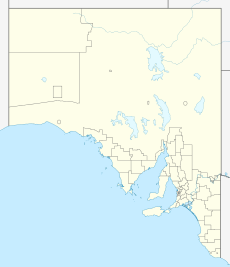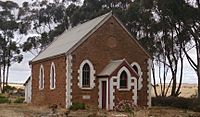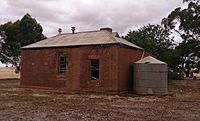Hanson, South Australia facts for kids
Quick facts for kids HansonSouth Australia |
|||||||||||||||
|---|---|---|---|---|---|---|---|---|---|---|---|---|---|---|---|
| Postcode(s) | 5417 | ||||||||||||||
| Time zone | ACST (UTC+9:30) | ||||||||||||||
| • Summer (DST) | ACST (UTC+10:30) | ||||||||||||||
| Location | |||||||||||||||
| LGA(s) | Regional Council of Goyder | ||||||||||||||
| Region | Yorke and Mid North | ||||||||||||||
| County | Stanley | ||||||||||||||
| State electorate(s) | Stuart | ||||||||||||||
| Federal Division(s) | Grey | ||||||||||||||
|
|||||||||||||||
|
|||||||||||||||
Hanson, once known as Davies, is a small town in South Australia. It is located about 29 kilometres (18 mi) north-east of Clare. You can also find it about 13 kilometres (8.1 mi) south-west of Burra. The town sits where the Barrier Highway meets the Hanson-Farrell Flat Road. It is part of the Regional Council of Goyder.
Hanson is also next to the old Peterborough railway line. It was the next train station from Burra towards Adelaide. For some time, Burra was the end of the line.
Contents
Hanson's History: A Town's Story
How Hanson Got Its Name
The town of Hanson was first surveyed, or mapped out, in 1865. It was originally called Daviestown, Davieston, or Davies Town. These names honored Sir Richard Davies Hanson (1805–1876). He was an important person in South Australia's history. Sir Richard was a Chief Justice and even acted as Governor of the colony from 1872 to 1873.
The very first pieces of land in the town were put up for sale on November 30, 1865.
The Name Change to Hanson
Around 1890, people decided to rename the town Hanson. However, the name was not officially changed until September 19, 1940. This change made the town's name match the name of the nearby Hanson railway station.
On the same day, another nearby town that was also known as Hanson officially became Farrell Flat. This also helped its name match its railway station.
What Hanson Was Like Over Time
Over the years, Hanson has been home to several important buildings. It had a church, a hall, and a school. There was also a shop, a railway station, and a few houses. These buildings helped the community grow and serve its residents.




